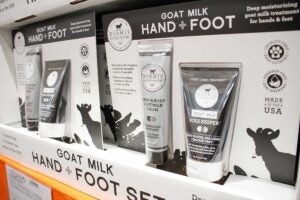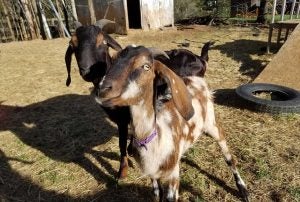There’s a lot to the dairy industry. Not only are there many options for milk and dairy products, but there’s also a wide range of breeds of dairy animals, and every farm is a little different. When you think about dairy, chances are dairy goats aren’t what comes to your mind!
But there are a lot of interesting things about this side of dairy and what makes dairy goats different from dairy cows.
First off, the dairy goat industry is a lot smaller than traditional dairy. There are 9.36 million milk cows in the United States and 410,000 dairy goats. Products from goats — such as cheese and yogurt — are consumed more widely around the world, but not as much in the U.S. The demand for goat milk and goat products is on the rise domestically, but remains strongest in Asia.
What makes dairy goats so different from dairy cows?
Dairy goats are used for their milk, meat, hair, skins, and more. They are also gaining popularity as pets, pack animals, and even brush control for fire reduction and vegetation control for cities and communities. Grocery stores and specialty shops sell goat milk, goat cheese, and even ice cream made with goat milk. Goat milk can also be used to make soaps, lotions, and other body care products. Goat milk tends to be whiter than whole cow milk. This means that butter and cheese made from goat milk are also white, but can be colored during processing.

Milk is an important (and great) source of calories and nutrients. Many people think that goat milk has a different taste than cow’s milk that takes some getting used to. In many countries other than the United States, the flavor of goat milk is preferred over cow milk.
Other than look and taste, goat milk is different to cow’s milk in a few ways. Goat milk is slightly higher in most nutrients — including calories, protein, fat, calcium, magnesium, phosphorus, and potassium — than cow’s milk. Goat milk is also naturally homogenized, which means that it is more uniform and fat molecules are evenly distributed throughout the milk. Overall, there isn’t a huge difference between goat milk and cow’s milk.
Interestingly, many people who are allergic to cow’s milk can consume goat milk products without experiencing an allergic reaction. This is usually not a lactose intolerance, but a difference in some of the other components of the milk such as there being less lactose and different forms of proteins in goat milk. (Look up A1 and A2 milk proteins in dairy!)
Dairy goats are smaller than cows and reach maturity much earlier, at about 4 to 5 months of age. Many people find it easier to keep goats since they need less space than cows. It’s also faster to build a herd of dairy goats. For people who want to produce milk for their family, a goat or multiple goats are often a good option. Even just one cow produces more milk than most families can consume, so goats are a good alternative.

The eight major dairy goat breeds in the United States are the Saanen, Sable, Nubian, Toggenburg, LaMancha, Oberhasli, Nigerian Dwarf, and Alpine. The lactation period for dairy goats averages 284 days, with peak production usually occurring four to six weeks after kidding.
Goats are well known for being able to “eat anything.” While this isn’t exactly true, goats can receive a high-quality diet from low-quality forages, including weeds and shrubs. This is why goats are often used to “clean up” brush and overgrown areas in cities. This can also make goats an interesting inclusion in fire reduction and control.
Goats milk can be used to make artisan cheese. Goat cheese can have many different flavors and textures, including anywhere from crumbly to creamy, young to mature, and mild to tangy. Goat cheese is very versatile and can be white, coated with ash or herbs, or wrapped in grape leaves.
One aspect of the dairy goat industry that is on the rise is commercial goat dairies. These dairies function like regular cow dairies and either process their own products or supply milk to creameries and companies who process and sell goat milk products. While many people with dairy goats started out with just a few animals, goat dairies tend to have more animals and produce a lot more milk.
Dairy goats are definitely a unique (and growing) sector of the dairy industry! These small animals can produce many products including milk, cheese, yogurt, ice cream, lotions, and soaps. Goats are also great at cleaning up brush and overgrown areas. While they are similar to dairy cows in some ways, they are also very different.
The next time you’re at the grocery store, try some goat milk or goat cheese, it just might be your new favorite!
Michelle Miller, the Farm Babe, is a farmer, public speaker, and writer who has worked for years with row crops, beef cattle, and sheep. She believes education is key in bridging the gap between farmers and consumers.



